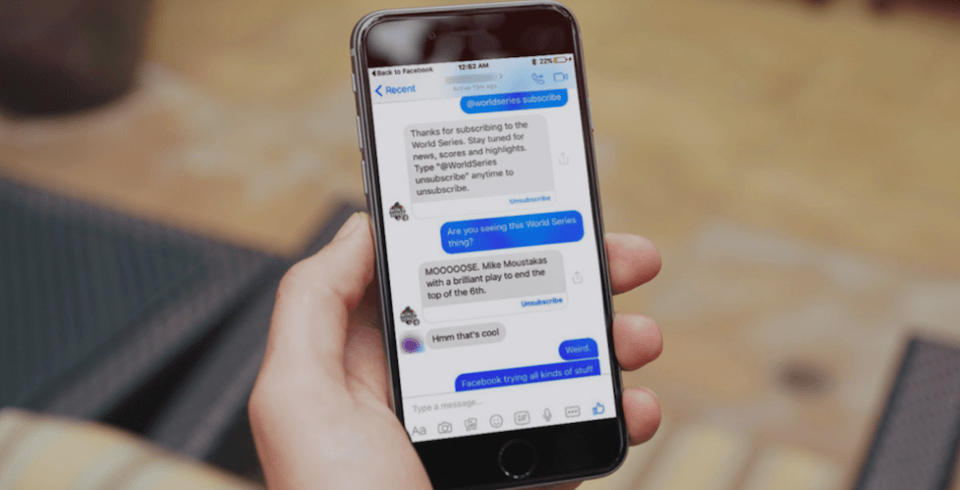Bots are now ready to be integrated into the messenger app of Facebook. Even if very few brands have already launched their own bot, this phenomenon already intrigues and introduces new issues into the digital and mobile ecosystem.
What is a bot?
Above all, it is important to distinguish two different types of existing bots: personal assistants such as Siri, Google Now or Cortana, which rely on artificial intelligence and are able to deal with a lot of information, and the bots which aim at a precise objective in order to accomplish a specific mission, thanks to a predefined scenario.
A bot is just like any other mobile app, but the interface is different. In this case, we are talking about a « conversational user interface » and not a « graphical user interface ». For the user, it is nothing less than a conversation. Today, conversations using bots are already available on different well-known platforms such as Skype, Slack, Telegram, Kik, Messenger or WeChat in Asia. This conversation can be completely textual or it can be enhanced with images and interactions. It can also be done with open questions or multi-answers questions just like H&M on Kik.
The main difference between bots and apps is that bots have a quickest execution. If I want to order a cab, I will talk to the Uber’s bot on Messenger. Downloading the app on the store becomes useless, because we can order the cab directly through our usual messaging app.
From a technical point of view, the bot is a program which analyses the content of the user’s requests expressed orally or textually. The bot will pick up in all the databases the information he needs to answer the user. Once the information is found, it will answer to the user with a sentence, an image or an interaction. There are several levels of complexity for a bot. On one hand, we can find the « vocal automated messaging » where the user can type 1,2 or 3 depending on the propositions, knowing that the bot is guided by a given scenario. On the other hand, users can express open sentences that the bot will need to decrypt, analyse and then interpret (if the user asks me this, then I will find this information and I will get back to him with it).
In order to understand better, here is a case of the different types of bots: the « simple » bot is the one you reach when you will call your insurer. The best example of an « evolved » bot is Siri, when we ask him if an umbrella will be necessary today, it will immediately understand that we want to know the weather of the day.
How can a company create its own bot?
A bot is a program that will « listen » to the user’s requests, that will go get the information necessary in one or several databases, and then get back to the user with the answer needed.
When a company wants to build its bot, it has to:
- Define the missions of the bot,
- Create instances of use. The creation of an app requires the work of a creative designer, whereas for a bot, it is only a matter of a scenario designer. For example, while ordering a taxi, the user is asking: (1) when the taxi is about to arrive; (2) where it is supposed to pick me up; (3) where I want him to drive me. In this situation, the user is leaded.
- Identify one or several data source in which the bot will look for information. The bot is then developed thanks to widespread technologies such as PHP, Ruby or Node.JS. Then, it will finally have to be hosted on a server controlled by it, unlike apps, which are hosted on the Apple Store/Google/Microsoft. For an editor, it is now possible to ask an agency to walk her through the development of its bot. Unlike apps, we do not need to redevelop the bot for each platform.
Like applications, it depends a lot on the complexity level for the asked type of bot (scenario, complexity of the interface, how many data sources). The estimation of the bot deployment can go from a few weeks for a simple bot with a tight scenario to several months for more complicated bots.
Bots, new robotic handymen?
The arrival of bots has inspired an all new approach of the interactions between man and machine. They define new uses and they are likely to modify our way to get to a service through our smartphone. Now, as the app market is ready, they can appear as a threat for this ecosystem, which struggle to renew itself and to have high adoption rate. It is also important to take into account the development costs, which are often an important break for the application’s editors.
All these indicators can be worrying facing the relative simplicity for the developers to create a bot and the success of the messaging app. As a service based on artificial intelligence, bots sometimes need a little more time for technology to evolve in order to settle down and to seduce permanently. Actual uses are not really convincing for now and they are leaving a doubt concerning a real democratization.
Mobile are for sure in constant evolution, and it will be fascinating to have a close look at the role that bots will take in our smartphones in the next few years. Will they be robotic handymen or will they coexist complementary to other applications?


